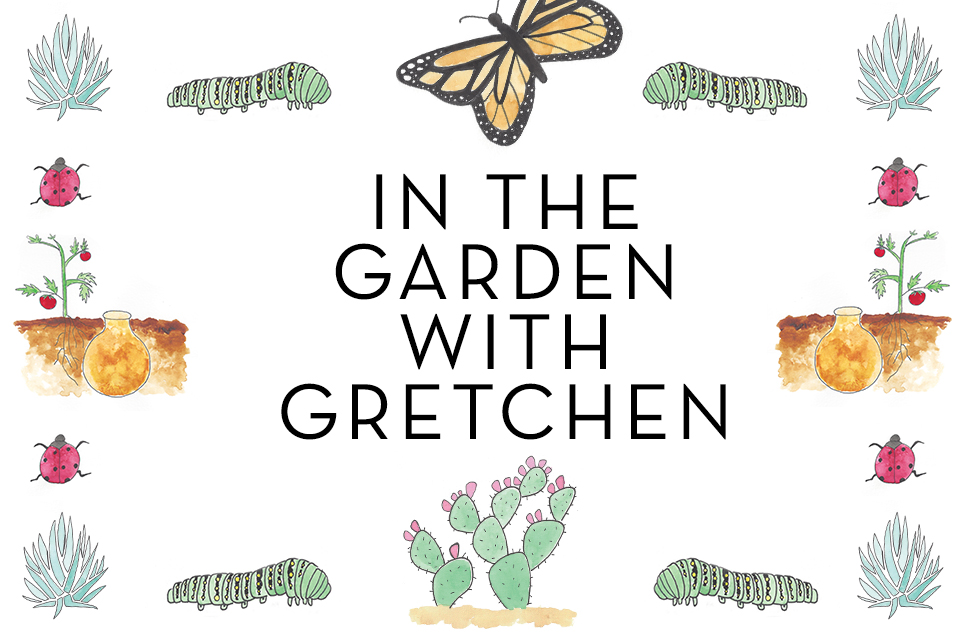In the Garden with Gretchen: How to Be a Good Garden Parent

There’s no better natural indicator of how fast time flies than to take a quick glance out the window at your growing garden. Those tiny seedlings sprout up so fast! It was just in March when we pulled out our power tools to build a raised garden bed. And in April, we got our gloves dirty by planting some seeds.
While you’re still new to being a garden parent, you’ve got a good enough green thumb to notice if there’s something bothering your plants.
As they start to grow, you might be “bugged” by the pests that seem to flock to your garden. While it tends to be our instinct to kill (or, if you’re like me, enter a debilitating state of panic) any insect that flies or crawls into our vicinity, it’s important to know which ones are beneficial.
The Good Guys
Ladybugs and butterflies, oh my! Conveniently enough, the pretty insects are the ones you’ll want to keep. Some bugs just have all the luck, don’t they?
Ladybugs aren’t always so attractive, though. They metamorphose, and the different forms they take prior to becoming a recognizable red beauty are actually really ugly. Many gardeners mistake ladybug larvae as a harmful intruder and end up extinguishing them. So, do a double take before disposing of any alligator-looking insects; it might just be a ladybug just going through its awkward stage. Have some sympathy; we’ve all been there! Our garden relies on ladybugs because they feed on aphids, and aphids are the worst.
Monarch and Swallowtail butterflies in particular reside in this safety zone, serving as pollinators. The Monarch population has been plummeting over the past couple of decades, so do your small part to mutually help one another by offering up a safe haven for them in your garden.
The Bad Guys
Aphids, also known as “plant lice” are the villains of your garden. They appear en masse and wreak havoc on your blossoming garden plants. An aphid infestation develops quickly and can appear in a variety of colors, but will commonly be spotted as all black or all white. They are extremely tiny, but cause major damage by sucking sap from the stems of your plants—eventually leading to plant death or fungus growth. Fortunately, you can fight them off sans-pesticide with the following solution.
Create an oil spray by combining 1 tablespoon of dish soap with 1 cup of cooking oil. Blend the mixture with water at a ratio of 4 teaspoons of oil mixture to 1 pint of water. Spray once a week to keep the aphids away.
Here’s where it starts to get confusing. While Monarch and Swallowtail butterflies are beneficial for your garden, Monarch and Swallowtail caterpillars need to be kept out. As caterpillars, they’ll harm your plants. Your best line of defense is observation. If you see either of these caterpillars feasting away, gently pick them up and put them elsewhere. My advice: plant a dill plant and/or milkweed plant as a deterrent. (These caterpillars love dill and milkweed, so having this option available will help keep them off of your fruits and veggies.)
Natives/Drought Resistant Plants
It’s hard to believe that anything can survive the Texas heat. But there are actually plants that thrive in this environment. If you’re worried you may be cursed with a black thumb or don’t want to take on the responsibility of a vegetable garden, these native, drought-resistant plants are the perfect way to improve your landscape:
Flowers for the Spring to Summer Season
• Blackfoot Daisy
• Texas Sage
• Esperanza
• Plumbago
Flowers for the Spring to Frost Season
• Grandma’s Yellow Rose
• Knockout Rose
• Verbena
Decorative Plants; Little or No Maintenance Required
• Blue Agave
• Squid Agave
• Softleaf Yucca
• Red Yucca
Edible Plants
• Chile Pequin
• Prickly Pear Cactus
• Upright Rosemary
Water Conservation
Rain in late spring and summer in Texas is difficult to rely on. Water conservation techniques make the most of the water we do get.
There are two incredibly easy methods to help you store and save water:
Rain Bucket
The next time it rains, take note of where the runoffs are around your house. Gutters are an easy go-to, but usually any area on a downward slope is an obvious choice. When the rain lets up, take the bucket to your plants. Repeat after the next rainfall. (Tip: If you empty your rain bucket after a day or two, mosquitos shouldn’t be a problem.)
Ollas
Olla pots are the guardian angels of raised garden beds. An olla (pronounced “oy-yah”) is a clay pot with micro-pores that allow water to seep out into the surrounding soil. Prior to planting anything, dig a deep hole in your garden and bury your olla until the mouth of the pot is about level with the top of the bed.
After you’ve planted everything in your garden, you can start putting your olla to work. Step one (and the only step): fill it up with water! The olla will slowly seep water out as the soil needs it, your roots will grow toward the water source, and it will help keep out weeds. Refill the olla once or twice a week.






